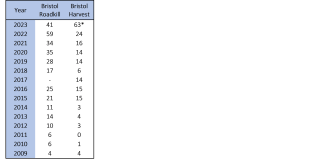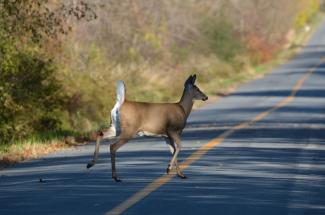DEM Highlights Hunting's Crucial Role in Wildlife Conservation and Managing Deer Populations
Published on Wednesday, January 17, 2024
PROVIDENCE, RI – The Rhode Island Department of Environmental Management (DEM) is highlighting the important role of hunting in conservation, managing deer populations, and providing funding for DEM's broader network of wildlife conservation efforts. Hunting has a long tradition in RI, supporting family customs, providing locally sourced meat, connecting people with nature, and attracting tourism to the state. DEM works to protect and enhance wildlife habitat in Rhode Island forests and management areas to ensure healthier, more diverse, and abundant wildlife populations. White-tailed deer are a common sight in Rhode Island. Regulated hunting has proven to be the most cost-effective, efficient, and successful method of controlling deer populations, which in turn ensures that the population remains in balance with ecological and social factors. DEM’s Division of Fish and Wildlife (DFW) runs a robust deer program, offering opportunities for hunters to harvest deer across the state with lengthy season, liberal bag limits, and extensive access to public lands. DFW biologists seek to balance deer hunting opportunities with maintaining a healthy deer population and reducing negative impacts associated with overpopulated deer, including agricultural crop losses, nuisance complaints from residents, and especially deer vehicle collisions (DVCs).
“Deer hunting is the most effective and economical option for managing deer populations, and is the primary management tool used by federal, state, and provincial wildlife agencies across North America,” said Dylan Ferreira, a Principal Wildlife Biologist in DFW. “Other options such as translocation and fertility control are cost prohibitive and have limitations rendering them ineffective in most scenarios. Relocating wildlife is illegal in Rhode Island under most circumstances and can spread parasites and diseases to new locations. Although Chronic Wasting Disease is not currently present in RI, it is spread primarily from the movement and transportation of live deer. Fertility control comes in the forms of contraceptive medication or physical sterilization, with both considered mainly unviable population control techniques when used alone due to low efficacy from multiple required dosages and the difficulty of capture. Both alternative options can lead to deer mortality from the stress of capture and require significant resources to capture, treat, sedate, operate on, or translocate deer. Legal regulated hunting remains the best method for managing deer population growth.”

Deer vehicle collisions (DVCs) are a public safety risk and can be costly, averaging around $6,717 per collision according to the Federal Highway Administration. Deer reproductive behavior is the main driver behind DVCs. During deer breeding season (known as the “rut”) beginning in late October and continuing through early December, deer tend to move around more frequently and is the peak period for DVCs. Deer do not often leave their home ranges in response to hunting, and there is no evidence for a correlation between hunting season and an increase in DVCs. In 2022, there were 1,544 reported DVCs in Rhode Island, an increase of ~20% compared to 2021 when 1,285 deer auto strikes were reported. In 2022, the number of reported DVCs was equivalent to 57% of the total reported hunter harvest according to DEM’s annual Deer, Deer Harvest and Deer Hunter Summary, which serves as a guide for future management decisions to maintain a healthy deer population.
In areas with overabundant deer issues, DFW works with local landowners such as municipalities, lands trusts, NGOs, or private landowners to open lands to public hunting in hopes to increase harvest to reduce the negative impacts associated with too many deer. In 2022, a deer hunting cooperative program with DEM was requested by the Town of Bristol and its constituents to manage its deer population, which has one of the highest rates of both DVCs and nuisance complaints from residents in Rhode Island. After an initial town meeting held in August, the Town Council voted unanimously in favor of the cooperative agreement with DEM opening four parcels of town-owned property to archery only deer hunting to reduce Bristol’s deer population. During the 2023 deer hunting season since the cooperative program began, Bristol’s deer harvest almost tripled that of 2022 and is four times higher than its five-year average. DVCs in Bristol have been increasing steadily since 2009, reaching a record high of 59 in 2022. Since the creation of cooperative hunting program with DEM, Bristol has seen a significant decrease in DVCs this year, with a 31% decrease from 59 to 41. DEM aims to continue expanding cooperative hunting agreements throughout Rhode Island to effectively manage the deer population and hopes to see a reduction in deer vehicle collisions across the state.
Another major concern expressed by the public is the risk of tick-borne diseases from ticks which feed on deer. Although there is an obvious correlation between deer and ticks, ticks do not get Lyme disease from deer as is commonly believed. Lyme disease is contracted by humans through the bacterium, Borrelia burgdorferi, through the bite of an infected deer tick. Deer are implicated as reservoirs and transmitters of zoonotic diseases as are many species of wildlife residing near human dwellings. Ticks require large mammals, such as deer, as a host for feeding and mating during their adult stage. Adult ticks lay eggs that hatch, after which the nymphs feed on small mammals or birds and become infected with the B. burgdorferi. The nymphs or adults located in brush and on tall grasses can then come into contact with humans as we pass through these environments. When a tick becomes infected and continues to feed on various hosts, tick-borne diseases can be transmitted.
DEM supports deer hunting through DFW’s Hunter Education Program. Safety training is required by law in Rhode Island for beginner hunters and to date, more than 40,000 people have completed a hunter safety course, helping to reduce related accidents in the state and elsewhere. Hunter Education promotes safe, ethical, and legal hunting practices preventing hunting related accidents nationally. Hunters are taught to clearly identify a target and what is beyond it before shooting. All archery deer hunters complete a hunter education class to obtain an archery deer permit. Archery proficiency testing is also required every two years to bow hunt on Prudence Island, Patience Island, Block Island National Wildlife Refuges, Trustom National Wildlife Refuge, John H. Chafee National Wildlife Refuge, Beavertail State Park, the Bristol town property co-op parcels, and anywhere in the town of Lincoln. During hunting seasons on lands open to public hunting, the public must wear solid, daylight fluorescent orange. Public lands remain safe for all visitors to enjoy while following this safety requirement. A complete schedule of hunter educational offerings is available online here.
Licensed hunters are law-abiding, respectful stewards of our natural resources and according to the recent Rhode Island Hunter Sentiment Survey, most hunters hunt for food rather than trophies. In addition to the sport of hunting and spending time in the outdoors, harvested deer are a great source of local, free-range, organic meat that hunters, their families, and friends consume in a variety of wild game recipes. RI’s 2022-23 deer hunting season yielded over 32 tons of consumable venison, equivalent to about 130,000 meals. Hunting deer is a traditional use of this natural resource and meat from harvested deer is not wasted but is often frozen and consumed throughout the year. By harvesting wild game, hunters reduce reliance on factory-farmed meat that often travels thousands of food miles to the grocery store. DEM’s enforced seasons, rules, regulations all aim to reduce and manage deer populations rather than eliminate them. Hunters remove a portion of the population, which alleviates competition for resources. During winter, food resources are scarce which can lead to starvation when there's an overpopulation of deer. Additionally, deer hunting season does not coincide with the animals raising their young. Environmental Police Officers from DEM’s Division of Law Enforcement (DLE) monitor lands that allow hunting statewide to enforce hunting laws and help protect public safety. DLE takes poaching very seriously as it steals opportunities from hunters that follow regulations and selfishly depletes RI’s precious natural resources.
Hunters provide funding for wildlife conservation through their purchase of firearms and ammunition through the Wildlife and Sportfish Restoration Program, and through the purchase of their state hunting licenses and permits. These funds are distributed to each state by the federal government and used to conserve land, manage habitat, restore wildlife populations, and much more. In 2023 alone, Rhode Island received $7,176,940 in funding for wildlife restoration from this program. Hunters and anglers purchase around 70,000 licenses, permits, stamps, and tags each year and contribute more than $235 million to Rhode Island's economy. With the help of hunters, DEM has protected thousands of acres for wildlife in RI, continued our research and monitoring efforts for both game and non-game birds and mammals, established a strong research partnership with University of Rhode Island, and continue to provide hunter education and wildlife outreach opportunities for the public. Without the contribution of legal and responsible hunters, DEM would not be able to conserve and protect our state's wildlife.
For more information on DEM programs and initiatives, visit www.dem.ri.gov. Follow DEM on Facebook, Twitter (@RhodeIslandDEM), or Instagram (@rhodeisland.dem) for timely updates.

